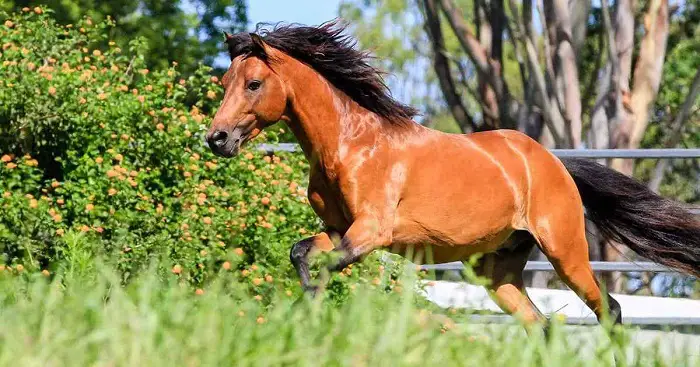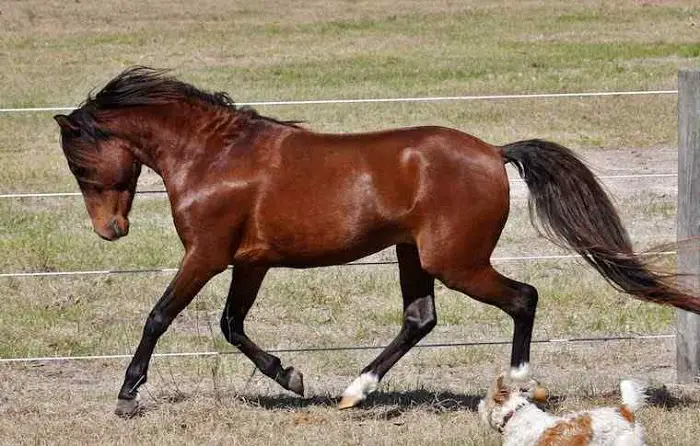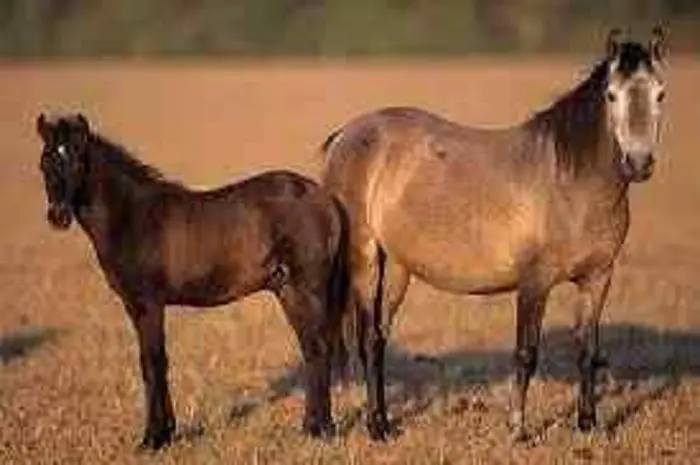The Caspian Horse is a rare and ancient breed of horse that originated from the Caspian Sea region, which is located in modern-day Iran. The breed is believed to be one of the oldest horse breeds in the universe, with evidence dating back more than 2,500 years.
The Caspian Horse is a small breed, with a height ranging from 9 to 11.2 hands (36 to 45 inches) and a weight of 400 to 600 pounds. They have a refined head with large eyes and small, pointed ears. Their neck is arched and muscular, and their body is compact with strong, well-developed legs.
Caspian Horses are known for their intelligence, courage, and athleticism. They are energetic and agile and excel in various disciplines, including driving, jumping, and dressage. The horse breeds are also known for their gentle and affectionate nature, making them great companion animals.
Unfortunately, the Caspian Horse is listed as an extremely endangered breed by the Rare Breeds Survival Trust, with only a few hundred individuals left. Efforts are being made to conserve and promote the breed, including breeding programs and conservation efforts in its native range.
Origin and History of the Caspian Horses
The Caspian horse is a small breed of horse considered one of the world’s oldest and purest breeds. The origins of the Caspian horses are partially transparent. Still, it is believed to have originated around the Caspian Sea, including modern-day Iran, Turkmenistan, and Azerbaijan.
The horse is depicted in ancient Persian artwork and has been mentioned in Persian literature for centuries. In the 7th century, Arab conquerors took Caspian horses to the Arabian Peninsula, where they were used to improve the breeding stock of Arabian horses. The Caspian horses were also used extensively by the Scythians, a nomadic people who lived in the region in ancient times.
During the 20th century, the Caspian horse was nearly extinct, with only a few individuals remaining. However, in 1965, a breeding program was established in Iran to save the breed, and the horse has since spread to other regions, including the United States, where the Caspian horses are now recognized as a distinct breed.
The Caspian horses are still relatively rare today, with only a few hundred individuals worldwide. However, the breed is prized for its beauty, intelligence, and versatility and is used for various purposes, including riding, driving, and as a children’s pony.
Physical Features of Caspian Horse
The Caspian horse is a small breed of horse, with a height of 9 and 11.2 hands (36 to 45 inches or 91 to 114 cm) at the withers and weighing between 400 and 500 pounds (180 to 225 kg). Despite its small size, the Caspian horse is well-proportioned and athletic, with a muscular build and a refined appearance.
The head of the Caspian horse is small and elegant, with large eyes, small ears, and a slightly dished profile. The neck is long and arched, and the chest is deep and broad. The back is short and robust, and the hindquarters have a high-set tail.
The Caspian horse has straight, strong legs, well-defined joints, and challenging, durable hooves. The breed has a soft, silky mane and tail, often long and flowing.
The coat of the Caspian horse can be any solid color, including black, bay, chestnut, gray, and palomino. The breed may also have white markings on the face and legs, and some individuals may have a dorsal stripe or other markings.
Overall, the Caspian horse is a small but athletic and elegant breed with a refined appearance and robust and durable body.
Height and Weight of Caspian Horse
The Caspian horse is a small breed of horse with a height between 9 and 11.2 hands (36 to 45 inches or 91 to 114 cm) at the withers. In terms of weight, the Caspian horse generally weighs between 400 and 500 pounds (180 to 225 kg).
To put this into perspective, a typical adult horse, such as a Thoroughbred, stands between 15 and 17 hands (60 to 68 inches or 152 to 173 cm) at the withers and weighs between 1,000 and 1,200 pounds (450 to 540 kg). Thus, the Caspian horses are significantly smaller and lighter than most other horse breeds.
Despite their small size, the Caspian horses are well-proportioned and athletic, with a muscular build and a refined appearance. The breed is known for its agility, speed, and endurance and can perform various activities, including riding, driving, and jumping.
Genetic Variations of Caspian Horse
The Caspian horse is a relatively small and homogeneous breed with limited genetic variation. However, like all horse breeds, the Persian horse has genetic variations that can affect its appearance and performance.
One common genetic variation in the Caspian horse is the presence of the agouti gene, which can affect the distribution of pigments in the horse’s coat. The agouti gene can result in different coat patterns, including bay, black, and chestnut.
Another genetic variation that can affect the Caspian horse is the presence of the gait gene, which can influence the horse’s movement. Some Caspian horses may have a naturally smooth gait, while others may have a more traditional trot or canter.
The Caspian horse may also carry other genetic variations common in horses, such as genes that influence coat color, height, and conformation. However, due to the breed’s limited genetic diversity, individual horses have less variation than other horse breeds.
The Caspian horse is a relatively genetically homogenous breed with limited genetic variation. However, the breed’s unique characteristics and history have made it a valuable and beloved member of the equine world.
Color and Markings of Caspian Horse
The Persian horse can come in various colors and markings, although the breed tends to have solid coat colors without significant markings. Caspian horses’ most common coat colors include bay, black, chestnut, and gray. Palomino and buckskin colors can also occur but are less common.
White markings, such as a star, snip, or blaze on the horse’s face, socks, stockings, or a coronet band on the legs, can occur in some individuals, but these markings tend to be limited. Some Caspian horses may also have a dorsal stripe, a dark stripe running down the middle of the horse’s back, although this is uncommon.
Caspian horses with spots, such as those seen in Appaloosa horses, are uncommon, and the breed is not typically bred for these markings. Overall, the Caspian horse is known for its solid coat colors and refined appearance rather than for dramatic markings or patterns.
Food and Nutrition of the Caspian Horse
The Caspian horses require a balanced diet that provides them with the essential dietary nutrients they need to maintain good health and perform at their best. The Caspian horse should always have access to fresh, clean water and high-quality hay or pasture.
Hay should be the primary source of forage in the horse’s diet and be good quality, free of mold, dust, or weeds. Horses should be fed hay based on their body weight and activity level, typically around 1.5% to 2% of their body weight per day.
In addition to hay, the Caspian horse may require additional feed to meet its energy and nutrient requirements, primarily if it is used for performance activities, such as riding or driving. Concentrate feeds, such as grains or pelleted feeds, can provide additional calories and nutrients, but they should be fed in moderation and based on the horse’s specific needs.
It’s important to note that horses should not be overfed, as excess weight can lead to health problems such as laminitis and obesity. Additionally, any changes to a horse’s diet should be made gradually over several days to allow the horse’s digestive system to adjust.
Health and Care of Caspian Horses
The health and care of the Caspian horse are similar to those of other horse breeds, but there are some considerations specific to this small and delicate breed. Here are some general guidelines for maintaining the health and well-being of a Caspian horse:
- Regular Veterinary Care: A Caspian horse should receive routine veterinary care, including vaccinations, deworming, and dental care. Regular check-ups can help detect and treat health problems early.
- Proper Nutrition: The Caspian horse requires a balanced diet that includes good quality hay or pasture and possibly additional concentrates to meet its energy and nutrient requirements. Fresh, clean water should be available at all times.
- Adequate Exercise: The Caspian horse should receive adequate exercise to maintain good health and prevent obesity. Exercise can include riding, driving, or turnout in a safe and secure pasture.
- Grooming: Regular grooming can help maintain the Caspian horse’s coat and skin health and help detect any injuries or health problems.
- Safe and Comfortable Living Environment: The Caspian horse should have access to a clean, safe, and comfortable living environment that provides adequate shelter, space, and ventilation. The horse’s living area should be regularly cleaned and maintained.
- Training and Handling: The Caspian horse is a sensitive and intelligent breed that responds well to positive reinforcement training and handling. Gentle, patient, and consistent training can help develop a strong bond between the horse and its caretaker and prevent behavioral problems.
In summary, the health and care of the Caspian horse require attention to nutrition, exercise, grooming, and veterinary care. The Caspian horse can live a long, healthy, and happy life with proper care.
Specific Diseases of Caspian Horse
Like all horses, the Caspian horse can be affected by various diseases and health problems. Here are some specific diseases that are known to affect the Caspian horse:
- Equine Recurrent Uveitis (ERU): This common eye disease can cause pain, inflammation, and vision loss in horses. Caspian horses are particularly susceptible to this condition, which is believed to be hereditary in the breed.
- Degenerative Suspensory Ligament Desmitis (DSLD): This degenerative disease affects the ligaments in horses’ legs, causing lameness and difficulty walking. Some Caspian horses have been reported to be affected by this condition.
- Laminitis in horses is a painful and potentially life-threatening condition affecting horses’ hooves. Various factors, including overfeeding, obesity, and metabolic disorders, can cause laminitis.
- Parasites: Caspian horses are susceptible to internal and external parasites like worms and ticks. Regular deworming and preventative measures can help prevent infestations.
- Colic: This is a general term used to describe abdominal pain in horses. Colic can have many causes, including dietary changes, stress, and gastrointestinal problems.
- Respiratory Infections: Caspian horses, like all horses, can be affected by respiratory infections such as equine influenza and strangles.
It’s important to note that not all Caspian horses will develop these conditions, and with proper care and management, many health problems can be prevented or managed. Regular veterinary check-ups and preventative measures can help keep Caspian horses healthy and happy.
Unique Features of Caspian Horse
The Caspian horse is a unique breed with several notable features, including:
- Small Size: The Caspian horses are one of the smallest breeds of horses in the world, with an average height of only 10 to 12 hands (40 to 48 inches). This small size makes them ideal for children and adults, driving, and other activities requiring graceful, agile horses.
- Athletic Ability: Despite their small size, Caspian horses are known for their athleticism and endurance. They are quick and agile and perform well in various activities, including jumping, dressage, and driving.
- Outstanding Conformation: The Caspian horse’s distinctive conformation sets it apart from other breeds. They have a refined head with large, expressive eyes, a short back, and a high-set tail. They also have a fine-boned, elegant appearance reminiscent of ancient horse breeds.
- Endangered Status: The Caspian horses are considered a critically endangered, with only a few hundred individuals remaining worldwide. Efforts are underway to preserve and promote the breed, including breeding programs and conservation initiatives.
- Historical Significance: The Caspian horse is believed to be one of the oldest breeds in the world, with a history that dates back thousands of years. They were used by ancient civilizations for transportation, war, and religious ceremonies and are mentioned in ancient texts and artwork.
In summary, the Caspian horse is a unique breed with a small size, athletic ability, distinctive conformation, and historical significance. Despite their endangered status, efforts are underway to preserve and promote this special horse breed.
Is the Caspian horse extinct?
No, the Caspian horse is not extinct, but it is considered a critically endangered breed. According to the Caspian Horse Society, only a few hundred individuals remain in the world, with the majority concentrated in Iran, where the breed is believed to have originated. However, efforts are underway to preserve and promote the breed, including breeding programs, conservation initiatives, and raising awareness about the Caspian horse and its historical and cultural significance.
Despite their small numbers, Caspian horses are valued for their athleticism, agility, and unique characteristics. Many dedicated individuals and organizations are working to ensure this unique breed of horse does not disappear.
Versatile Uses of Caspian Horses
Caspian horses are versatile animals that can be used for various purposes. Here are some common uses of Caspian horses:
- Riding: Despite their small size, Caspian horses can be ridden by children and small adults. They have a smooth gait and are well-suited for pleasure and trail riding.
- Driving: Caspian horses are nimble and agile, making them well-suited for driving in harness. They can pull a carriage or cart, often used in driving competitions.
- Showing: Caspian horses are an increasingly popular choice for showing, particularly in-hand classes where their refined appearance and distinctive conformation can be showcased.
- Equine Therapy: Caspian horses are gentle and friendly, making them well-suited for equine-assisted therapy programs. They can provide emotional support and physical benefits to people with various conditions, including autism, PTSD, and physical disabilities.
- Cultural and Historical Events: Caspian horses have a long and storied history and are often used in cultural and historical events to showcase their unique characteristics and heritage.
Caspian horses are versatile animals that can excel in various activities and roles. Their small size and distinctive appearance make them well-suited for particular disciplines, such as driving and showing. Their gentle nature makes them a popular choice for therapy programs.
Concluding Remarks on Caspian Horses
In conclusion, the Caspian horses are unique and exciting breeds with a rich history and distinctive characteristics. Despite their small size and endangered status, these horses continue to be valued for their athleticism, agility, and versatility. Their gentle and friendly disposition makes them well-suited for various activities, including riding, driving, therapy, and cultural and historical events.
Efforts are underway to conserve and promote the breed, including breeding programs, conservation initiatives, and educational outreach. As one of the oldest breeds of horse in the world, the Caspian horse holds a special place in the history and culture of Iran and the surrounding region and is a testament to the enduring bond between humans and horses.


